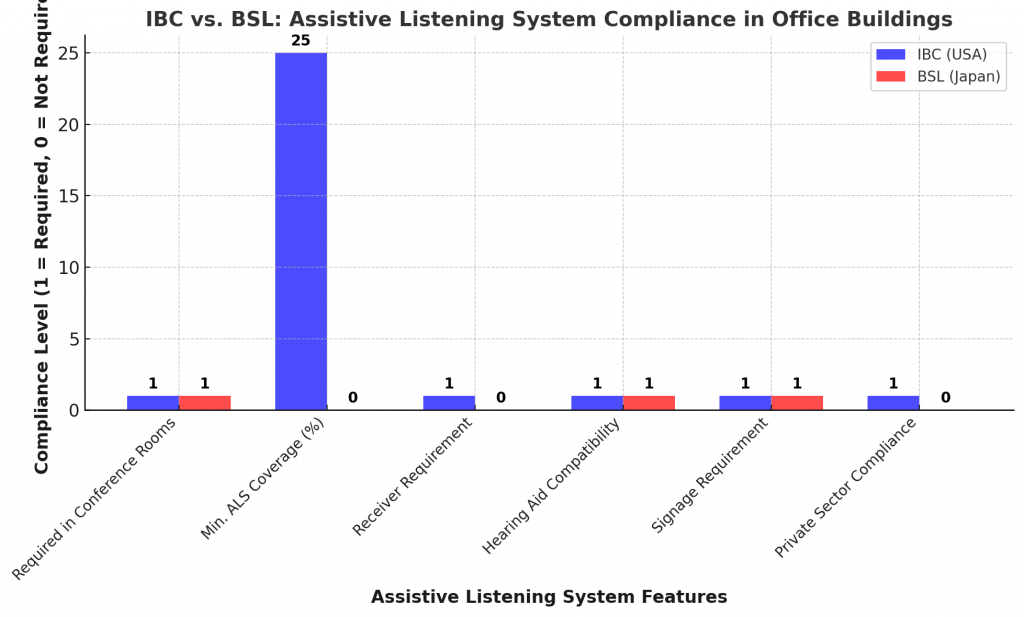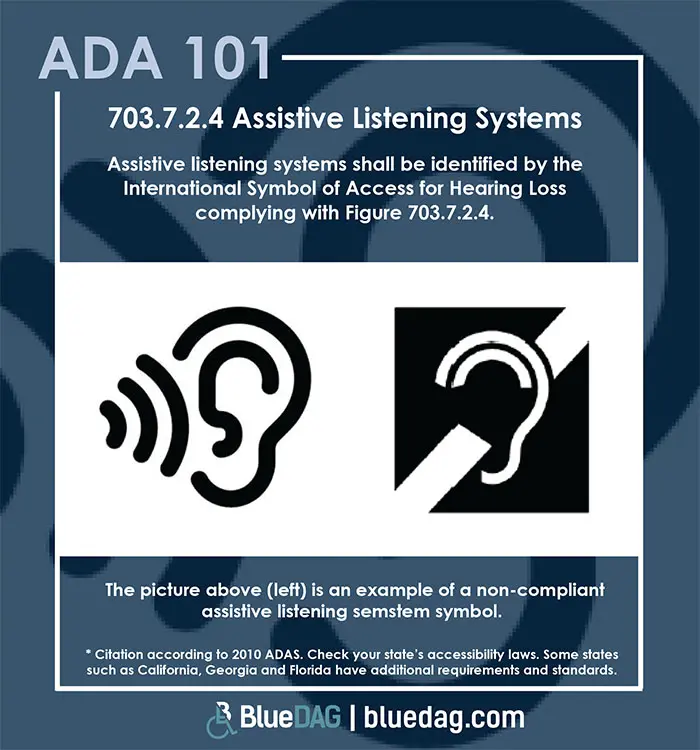- Assistive Listening Systems (ALS) are critical for ensuring effective communication accessibility for individuals with hearing impairments in spaces where audible communication is essential. Both the IBC (USA) and BSL (Japan) include provisions requiring the installation of ALS in specific settings.
IBC (USA) – Requirements for Assistive Listening Systems
Under the International Building Code (IBC 1108.2.7) and 2010 ADA Standards for Accessible Design (Section 219 & 706), Assistive Listening Systems (ALS) are required in assembly areas where audible communication is integral to the use of the space.
Key Requirements
- Where ALS is Required
- Any space with fixed seating and an audio amplification system must have ALS.
- Applies to conference rooms, meeting spaces, auditoriums, lecture halls, courtrooms, theaters, and classrooms.
- Minimum ALS Coverage
- At least 25% of the total seating capacity (but not fewer than two seats) must be ALS-equipped.
- For venues with more than 50 seats, ALS must be provided for at least 4% of the seats.
- Example:
- A 200-seat auditorium requires at least 8 ALS-equipped seats.
- Receiver Requirements
- A minimum number of ALS receivers must be provided based on seating capacity:
- 50 or fewer seats → At least 2 receivers.
- 51-200 seats → At least 2 receivers + 1 per 25 seats above 50.
- 201+ seats → At least 2 receivers + 1 per 50 seats above 200.
- A minimum number of ALS receivers must be provided based on seating capacity:
- Hearing Aid Compatibility
- ALS must be compatible with telecoil (T-coil) hearing aids.
- Induction loop systems, FM, or infrared-based ALS are typically used.
- Signage Requirements
- Clear informational signage must be provided indicating the availability of ALS.
- The signage must include the International Symbol of Access for Hearing Loss (ISAHL).
BSL (Japan) – Requirements for Assistive Listening Systems
Japan’s Barrier-Free Act (バリアフリー法, 2006) mandates assistive listening systems in public and government facilities but does not explicitly require them in all private-sector conference rooms.
Key Requirements
- Where ALS is Required
- Required in public buildings, administrative offices, government meeting halls, and cultural facilities.
- Strongly encouraged in conference rooms, lecture halls, theaters, and hospitals.
- Hearing Assistance Technology
- ALS systems should use inductive loops, infrared, or FM systems.
- Most public offices, train stations, and municipal centers are required to have hearing aid-compatible solutions.
- Coverage & Receiver Requirements
- Unlike IBC, Japan’s Barrier-Free Act does not specify a minimum percentage of seats requiring ALS.
- Instead, ALS systems must be available in key areas upon request.
- Universal Design Approach
- Many modern conference facilities in Japan voluntarily integrate induction loops and wireless ALS receivers as part of universal design initiatives.
- Government vs. Private Sector Compliance
- Public sector: ALS is mandatory in courts, government buildings, and administrative halls.
- Private sector: Compliance is not always mandatory, but many corporate offices and conference centers adopt ALS voluntarily.
- Signage Requirements
- Similar to IBC, clear signage must indicate the availability of ALS.
- The Barrier-Free Act encourages touchscreen kiosks and visual assistive technologies as additional communication aids.
Comparison Table: IBC vs. BSL – Assistive Listening System Requirements
| Feature | IBC (USA) – Required | BSL (Japan) – Required in Public Buildings |
| Where ALS is Required | Meeting rooms, theaters, lecture halls, courtrooms | Public admin offices, government meeting halls, cultural centers |
| Minimum ALS Coverage | 25% of fixed seating must have ALS | No fixed percentage, but systems must be available |
| Receiver Requirement | Based on seating capacity (2-25 minimum) | No strict numerical requirement, must be available on request |
| Hearing Aid Compatibility | Required (T-coil and hearing aid-compatible systems) | Encouraged but not strictly required |
| Signage Requirement | Mandatory with ISAHL symbol | Mandatory in public buildings, encouraged in private spaces |
| Private Sector Enforcement | Strictly required if audio amplification is used | Voluntary but widely adopted |
Case Study
ALS Implementation in a Mixed-Use Office Building – IBC vs. BSL
Project Overview
- A five-story mixed-use office building is being developed in two locations:
- Los Angeles, USA (IBC jurisdiction)
- Tokyo, Japan (BSL jurisdiction)
The building includes
- Conference rooms on levels 2 and 3
- Public meeting spaces
- A 150-seat auditorium for corporate presentations
The design team must ensure compliance with ALS requirements in both locations.
IBC Compliance (USA)
- Challenge:
- The conference rooms and auditorium require ALS based on IBC 1108.2.7.
- The original design did not include hearing loop systems.
- Solution:
- Installed induction loop ALS systems in the auditorium and main conference room.
- Provided six ALS receivers for the 150-seat auditorium.
- Added clear signage at all entrances.
BSL Compliance (Japan)
Challenge:
- The Tokyo-based office conference rooms did not originally include ALS.
- ALS is not explicitly required in private offices but is encouraged for universal design.
Solution:
- Installed ALS in public meeting areas and the main auditorium.
- Used FM wireless systems instead of induction loops to allow flexibility.
- Added assistive listening kiosks for real-time speech-to-text conversion.

Final Universal Design Approach for Both Locations
To ensure both IBC and BSL compliance, the project adopted a universal approach:
- Installed ALS in all major meeting spaces regardless of jurisdiction.
- Provided a mix of ALS technologies (Inductive loops in the USA, FM systems in Japan).
- Added signage with international accessibility symbols in both locations.
- Integrated speech-to-text assistive screens for real-time captions.
Key Takeaway
- The USA’s IBC strictly mandates ALS in meeting spaces with audio systems.
- Japan’s BSL requires ALS mainly in public facilities, while private offices integrate ALS as part of universal design efforts.
- A universal design approach ensures full accessibility regardless of legal mandates.
Global Approach for Assistive Listening Systems (ALS)
- Required Locations:
- Require ALS in meeting rooms, theaters, lecture halls, courtrooms, public administration offices, government halls, and cultural centers.
- Minimum ALS Coverage:
- Adopt IBC’s 25% minimum coverage standard in fixed-seating spaces, ensuring broad accessibility.
- Receiver and Compatibility:
- Standardize receiver availability based on seating capacity (minimum 2-25 units), and mandate hearing aid compatibility (T-coil systems).
- Signage:
- Require mandatory signage using the ISAHL symbol universally.
- Private Sector Enforcement:
- Mandate ALS in spaces utilizing audio amplification, fostering comprehensive auditory accessibility across public and private sectors.

706 Assistive Listening Systems
- 706.2 Receiver Jacks. Receivers required for use with an assistive listening system shall include a 1/8 inch (3.2 mm) standard mono jack.
- 706.3 Receiver Hearing-Aid Compatibility. Receivers required to be hearing-aid compatible shall interface with telecoils in hearing aids through the provision of neckloops.
- 706.4 Sound Pressure Level. Assistive listening systems shall be capable of providing a sound pressure level of 110 dB minimum and 118 dB maximum with a dynamic range on the volume control of 50 dB.
- 706.5 Signal-to-Noise Ratio. The signal-to-noise ratio for internally generated noise in assistive listening systems shall be 18 dB minimum.
- 706.6 Peak Clipping Level. Peak clipping shall not exceed 18 dB of clipping relative to the peaks of speech.

